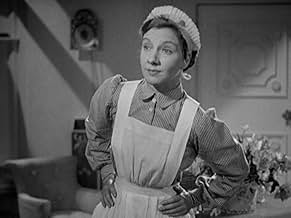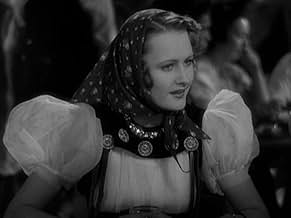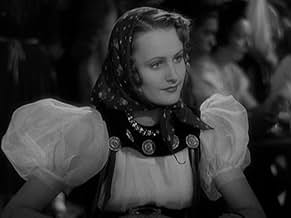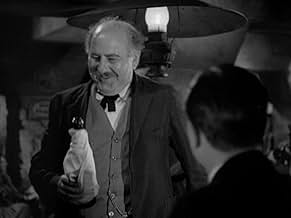VALUTAZIONE IMDb
6,3/10
1326
LA TUA VALUTAZIONE
Aggiungi una trama nella tua linguaA lounge singer is sent by a count to pose as a wealthy socialite.A lounge singer is sent by a count to pose as a wealthy socialite.A lounge singer is sent by a count to pose as a wealthy socialite.
- Regia
- Sceneggiatura
- Star
Mary Philips
- Maria
- (as Mary Phillips)
Rafael Alcayde
- Hotel Clerk
- (non citato nei titoli originali)
Nino Bellini
- Cosmos Club Waiter
- (non citato nei titoli originali)
Agostino Borgato
- Cordellera Bar Waiter
- (non citato nei titoli originali)
Adriana Caselotti
- First Peasant Girl
- (non citato nei titoli originali)
Robert Cauterio
- Hotel Clerk
- (non citato nei titoli originali)
Irene Coleman
- Cosmos Club Hat Check Girl
- (non citato nei titoli originali)
Gino Corrado
- Cosmos Club Croupier
- (non citato nei titoli originali)
Recensioni in evidenza
I've never been a fan of Joan Crawford, so it's always a surprise to find a performance of hers that really wins me over. I liked her in Grand Hotel (as 'Flaemmchen,') and I liked her again, very much, as Anni, the cheap night-club singer masquerading as a lady. Often seen in hard and brittle roles, Crawford has a very different look in this film, and expresses a vulnerability that brings her character to life. (Billie Burke is also notable, in the small but juicy role of the acid-tongued Contessa. And Franchot Tone has never been more likable.)
The Bride Wore Red is certainly built according to studio formula, but it also embodies all the earnest craftsmanship that characterized the studio system. The film at times seems clichéd, but it fully redeems itself through genuine empathy for the characters. And through its very strong premise: a 'scarlet' woman driven by hunger for the good life, who is given a slim chance of joining the upper class - provided she's cold and deceitful enough.
Until the final act, I really felt that the film could have gone either way: warm-hearted romance or bitter tragedy. The delicate balancing act makes it hard to achieve a satisfying pay-off. But the ending does succeed, thanks to a couple of nicely orchestrated scenes, and to the talent and charisma of Ms Crawford. These do make us believe that Anni could only choose as she does.
I was a bit sorry the film didn't delve just a little deeper into the moral and social dimensions. Anni's real problem is not what she wants, but rather what she may have to give up in order to get it. That distinction is not made entirely clear, leaving the film a bit too reliant on the old cliché that 'wealth doesn't bring true happiness.' But there's more going on here. Anni's 'tragic flaw' is not the hunger itself, but her willingness to give up honesty, morality and even true love. This distinction becomes almost subliminal, but it's there, and gives the film a slightly sharper edge. Anni is a character we can identify with and possibly admire, even when she's doing something despicable.
If you're in the mood for a traditional, old-style Hollywood entertainment, you won't go wrong with The Bride Wore Red. This is one of the good ones, a film I'd gladly watch again any time.
The Bride Wore Red is certainly built according to studio formula, but it also embodies all the earnest craftsmanship that characterized the studio system. The film at times seems clichéd, but it fully redeems itself through genuine empathy for the characters. And through its very strong premise: a 'scarlet' woman driven by hunger for the good life, who is given a slim chance of joining the upper class - provided she's cold and deceitful enough.
Until the final act, I really felt that the film could have gone either way: warm-hearted romance or bitter tragedy. The delicate balancing act makes it hard to achieve a satisfying pay-off. But the ending does succeed, thanks to a couple of nicely orchestrated scenes, and to the talent and charisma of Ms Crawford. These do make us believe that Anni could only choose as she does.
I was a bit sorry the film didn't delve just a little deeper into the moral and social dimensions. Anni's real problem is not what she wants, but rather what she may have to give up in order to get it. That distinction is not made entirely clear, leaving the film a bit too reliant on the old cliché that 'wealth doesn't bring true happiness.' But there's more going on here. Anni's 'tragic flaw' is not the hunger itself, but her willingness to give up honesty, morality and even true love. This distinction becomes almost subliminal, but it's there, and gives the film a slightly sharper edge. Anni is a character we can identify with and possibly admire, even when she's doing something despicable.
If you're in the mood for a traditional, old-style Hollywood entertainment, you won't go wrong with The Bride Wore Red. This is one of the good ones, a film I'd gladly watch again any time.
Well, you can't blame Joan for trying. Always wanting to go beyond that glamorous clothes-horse/shopgirl-makes-good mold in which MGM so successfully cast her throughout the 1930's, she was always attempting to outreach her grasp. When Metro's Austrian star Luise Rainer backed out of making a film of Molnar's THE GIRL FROM TRIESTE, a dark photoplay about a prostitute sent on a masquerade in the Tyrolean Alps, Crawford grabbed it, hoping to get her teeth into a meaty role. Imagine her chagrin when Metro executives "improved" the piece to be more suitable for Crawford's image, taking the meat and guts with it. What emerged was an uncomfortable picture built on compromises in an attempt to graft a typical Crawford/Cinderella plot onto what is basically a nasty, mean little story. Registering far below the Crawford usual at the paybox, THE BRIDE WORE RED started her career to skid.
A closer look, however, reveals that not all of the edge has been softened from the piece. I wholeheartedly agree with the reviewer who calls this Joan's most underrated performance, and there is a reason we do not sympathize with this Cinderella. Crawford's Anni is cold and snappish, and has the potential to do real harm to some nice, decent folk. The film plays like the dark side of all of those rags-to-Adrian gown stories Crawford played in the Metro phase of her career, and CRAWFORD IS FULLY AWARE OF THIS. Although seemingly played straight, there is an irony underneath that tells us Crawford herself isn't crazy about Anni either. It's understandable that 1937 audiences did not warm to a Joan they couldn't root for (even her hair is cut into a severe, but stunning, pageboy), but it deserves real recognition now that we are removed from the era and have seen ALL the phases of Crawford's career. In many ways, it's a harbinger of the darker, icier roles she was to play at Warner Bros. and throughout the 1950's.
The performances are uniformly good, with George Zucco strong as the decadent, evil Machiavelli who sends Anni on her masquerade, but Crawford, for the most part, is the standout. Only in the early scenes of the film, when she attempts to portray Anni as a world-weary honky tonk singer (in what must have been the cleanest, most glamorous "dive" in all of Trieste!!) does she fail to convince.
(Ironically, Crawford's next film, MANNEQUIN, released early in 1938 and co-starring Spencer Tracy, was a strictly paint by the numbers Rags-to-Adrian tale, inferior to this, that found great favor with the movie-going public.)
A closer look, however, reveals that not all of the edge has been softened from the piece. I wholeheartedly agree with the reviewer who calls this Joan's most underrated performance, and there is a reason we do not sympathize with this Cinderella. Crawford's Anni is cold and snappish, and has the potential to do real harm to some nice, decent folk. The film plays like the dark side of all of those rags-to-Adrian gown stories Crawford played in the Metro phase of her career, and CRAWFORD IS FULLY AWARE OF THIS. Although seemingly played straight, there is an irony underneath that tells us Crawford herself isn't crazy about Anni either. It's understandable that 1937 audiences did not warm to a Joan they couldn't root for (even her hair is cut into a severe, but stunning, pageboy), but it deserves real recognition now that we are removed from the era and have seen ALL the phases of Crawford's career. In many ways, it's a harbinger of the darker, icier roles she was to play at Warner Bros. and throughout the 1950's.
The performances are uniformly good, with George Zucco strong as the decadent, evil Machiavelli who sends Anni on her masquerade, but Crawford, for the most part, is the standout. Only in the early scenes of the film, when she attempts to portray Anni as a world-weary honky tonk singer (in what must have been the cleanest, most glamorous "dive" in all of Trieste!!) does she fail to convince.
(Ironically, Crawford's next film, MANNEQUIN, released early in 1938 and co-starring Spencer Tracy, was a strictly paint by the numbers Rags-to-Adrian tale, inferior to this, that found great favor with the movie-going public.)
I had high hopes for this one. The plot sounded good. Eccentric Count Armalia (George Zucco) believes that luck of birth is all that separates the rich from the poor. To prove his point, he sets up dive singer Anni (Joan Crawford) as a fake socialite to fool his rich friends. This works but snobbish Robert Young falls for her and wants to marry her. Anni sees the chance to get out of poverty by marrying a rich guy but, at the same time, she has started to fall for poor Franchot Tone. So it becomes a question of whether Anni will choose love or money. Glossy MGM soaper with a nice cast but somehow just misses the mark. It was nice seeing George Zucco in a different kind of role. Also Billie Burke is sort of evil, which is interesting. See it for the cast or out of curiosity. You might enjoy it more than me.
Dorothy Arzner is the director of this film, and though she does not make a lot of films, she usually makes rather substantial ones. This is certainly a substantial one.
The most appealing aspect of this production is the chemistry and loveliness of the couple played on screen by Joan Crawford and Franchot Tone (married in real life). This is not the only film that MGM has costarred them in together, but in this picture, it is easy to see the magic they create.
For his part, Robert Young is a worthy costar. And so is Joan's dazzling dress, referenced in the title. One must not forget to mention the always splendid Billie Burke, directed in several other pictures by Arzner. This time she portrays a real shrew, not her trademark scatterbrained character.
The most appealing aspect of this production is the chemistry and loveliness of the couple played on screen by Joan Crawford and Franchot Tone (married in real life). This is not the only film that MGM has costarred them in together, but in this picture, it is easy to see the magic they create.
For his part, Robert Young is a worthy costar. And so is Joan's dazzling dress, referenced in the title. One must not forget to mention the always splendid Billie Burke, directed in several other pictures by Arzner. This time she portrays a real shrew, not her trademark scatterbrained character.
The plot may not be a novel one, but the title was appetising and so were the cast. 'The Bride Wore Red' was seen as part of one of many completest quests (seeing as many films not yet seen of the person in question as possible), this one being for Joan Crawford. As well as Crawford, we have other talented performers in Franchot Tone, Robert Young, George Zucco and Billie Burke. All of whom are great when with good material and in the right roles.
Although 'The Bride Wore Red' is not among the best of all involved (all have also been far worse served) or one of the best of the genre, it is still well worth watching and has a lot of positive traits. It didn't deserve to be a flop. As far as Crawford's 30s films go, which were a mixed lot in quality, 'The Bride Wore Red' somewhere around solid middle, and anybody that loves romance and comedy individually and together are likely to (not guaranteed as not everybody has the same tastes for everything) find a lot to enjoy. The case with me.
Is 'The Bride Wore Red' perfect? No. The story, despite the premise actually being good, has few surprises and can be very silly with some suspension of disbelief needed at times later on. Also felt that the start was on the dull side but once the main plot kicks in properly there is a lot more energy.
Do agree that Anni's conflict with what she wants and what she has to give up could have gone into more detail, that could have been a fascinating angle and added so much to Anni's character and given her more heart.
Crawford, looking stunning, however gives it her all without over-acting to the point of overbalancing the rest of the cast or film. She doesn't phone it in either once the plot gets going, despite being on the cold side at the beginning. Tone has one of the more likeable characters and is charming and suave. Young has some of the more juicier lines and brings a nice edge and sophistication to them. Zucco is convincingly decadent and Burke is in an atypically shrews viper sort of role and plays it to the hilt.
Found the script to be amusingly droll and that it did sparkle. The story wasn't perfect but it had energy and charm and the chemistry between the cast was beautifully pitched, the three leads work more than convincingly together. 'The Bride Wore Red' looks great, especially Crawford's wardrobe and the luminous photography. Franz Waxman's score is sumptuous without being too loud or melodramatic. Dorothy Azner's direction is a bit bland and slow to begin with, but becomes more assured as the film goes along.
Summing up, nice enough if not mind-blowing. 7/10
Although 'The Bride Wore Red' is not among the best of all involved (all have also been far worse served) or one of the best of the genre, it is still well worth watching and has a lot of positive traits. It didn't deserve to be a flop. As far as Crawford's 30s films go, which were a mixed lot in quality, 'The Bride Wore Red' somewhere around solid middle, and anybody that loves romance and comedy individually and together are likely to (not guaranteed as not everybody has the same tastes for everything) find a lot to enjoy. The case with me.
Is 'The Bride Wore Red' perfect? No. The story, despite the premise actually being good, has few surprises and can be very silly with some suspension of disbelief needed at times later on. Also felt that the start was on the dull side but once the main plot kicks in properly there is a lot more energy.
Do agree that Anni's conflict with what she wants and what she has to give up could have gone into more detail, that could have been a fascinating angle and added so much to Anni's character and given her more heart.
Crawford, looking stunning, however gives it her all without over-acting to the point of overbalancing the rest of the cast or film. She doesn't phone it in either once the plot gets going, despite being on the cold side at the beginning. Tone has one of the more likeable characters and is charming and suave. Young has some of the more juicier lines and brings a nice edge and sophistication to them. Zucco is convincingly decadent and Burke is in an atypically shrews viper sort of role and plays it to the hilt.
Found the script to be amusingly droll and that it did sparkle. The story wasn't perfect but it had energy and charm and the chemistry between the cast was beautifully pitched, the three leads work more than convincingly together. 'The Bride Wore Red' looks great, especially Crawford's wardrobe and the luminous photography. Franz Waxman's score is sumptuous without being too loud or melodramatic. Dorothy Azner's direction is a bit bland and slow to begin with, but becomes more assured as the film goes along.
Summing up, nice enough if not mind-blowing. 7/10
Lo sapevi?
- QuizDuring filming, an electrician fell from the catwalk high above the set, narrowly missing the film's star, Joan Crawford. Shooting was temporarily halted while the man was rushed to hospital. Crawford refused to resume production until she was assured that the man would be fully cared for, that he would remain on salary, and that his family would be provided for. Crawford also called the hospital each day afterwards for reports on his condition.
- Citazioni
Rudolph 'Rudi' Pal: In my opinion, most people prefer sardines to caviar because most people haven't tried caviar.
- Curiosità sui creditiDuring the opening credits, a music box is shown playing a tune in the background.
- ConnessioniFeatured in The Romance of Celluloid (1937)
- Colonne sonoreWho Wants Love?
(1937)
Music by Franz Waxman
Lyrics by Gus Kahn
Sung by Joan Crawford (uncredited) at the Cordellera Bar
Played throughout as part of the score
I più visti
Accedi per valutare e creare un elenco di titoli salvati per ottenere consigli personalizzati
- How long is The Bride Wore Red?Powered by Alexa
Dettagli
- Data di uscita
- Paese di origine
- Lingua
- Celebre anche come
- The Bride Wore Red
- Luoghi delle riprese
- Austria(Alpine exteriors)
- Azienda produttrice
- Vedi altri crediti dell’azienda su IMDbPro
Botteghino
- Budget
- 960.000 USD (previsto)
- Tempo di esecuzione
- 1h 43min(103 min)
- Colore
- Proporzioni
- 1.37 : 1
Contribuisci a questa pagina
Suggerisci una modifica o aggiungi i contenuti mancanti




































